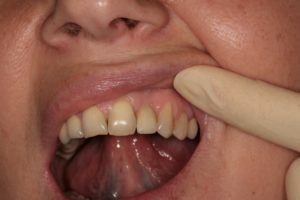 When all necessary procedures and medical manipulations are completed during the preparation of the tooth for the upcoming prosthesis, a crown is installed on it. At this point, the patient seems to think that the most terrible thing is already behind and the problem tooth will not bother him for a very long time.
When all necessary procedures and medical manipulations are completed during the preparation of the tooth for the upcoming prosthesis, a crown is installed on it. At this point, the patient seems to think that the most terrible thing is already behind and the problem tooth will not bother him for a very long time.
But unfortunately, no one is immune from exceptions. Sometimes the tooth under the crown starts to hurt. Discomfort can be felt under the influence of certain factors or permanently. After installing the crown, the tooth may become troubled immediately or not manifest itself for several months or even years.
What can be the cause of toothache under the crown? How can you relieve the unpleasant sensations before visiting a specialist? And what will the dentist do in this case?
Contents
- Why does the tooth hurt under the crown?
- Low-quality treatment
- Perforation of the tooth root
- Fracture of the tool in the tooth canal
- Why did the gingiva become inflamed?
- What should I do if I have toothache before going to the dentist?
- Drug therapy
- Phytotherapy
- Treatment at the dentist
Why does the tooth hurt under the crown?
Crowns are usually installed on dead teeth. Before prosthetics, a nerve is removed from the living tooth - it is depulled. Only after this, the crown is fixed.
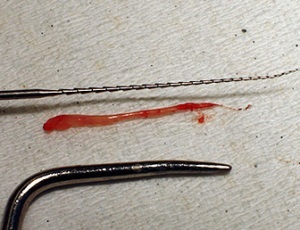
Remote tooth pulp
If the nerve is not previously removed, then some time after installing the prosthesis, the patient may encounter a toothache and other unpleasant sensations. This occurs in case of insufficiently qualitative treatment of caries and inflammation of the nerve or a burn of the pulp when the dentin is rubbed before prosthetics. In this situation, the tooth begins to respond to hotter.
There are three main reasons why most often the dead tooth begins to hurt under the crown.
- Low-quality treatment and preparation of a tooth for the installation of a permanent prosthesis;
- Perforation of the wall of the canal;
- Fracture of the tool part during cleaning or channel sealing.
Low-quality treatment
Pain of the tooth under the crown as a result of poor-quality treatment can occur when its channels have been sealed insufficiently. Especially often this happens with roots having bends. In this case, the dentist may not seal the space at the very tip of the root, which subsequently becomes an attractive place for the reproduction of bacteria.
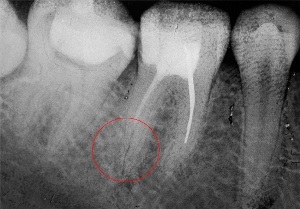
In the photo not completely sealed tooth canal
Even if the roots are completely filled during the treatment, the filling material may not be sufficiently compacted. Then there are small voids in it. Over time, the substance becomes denser, which also leads to cavity formation.
Finally, the case can be directly in the filling material. If it is substandard, then in time it may subsidence and the appearance of empty places in the upper part of the tooth. This leads to inflammation( periodontitis), the formation of purulent masses and painful sensations under the crown, especially when pressing.
Perforation of the tooth root
Perforation means the formation of a nonphysiological, artificial hole in the tooth wall. This can happen in two cases: when cleaning the tooth channels and during the installation of the pin.
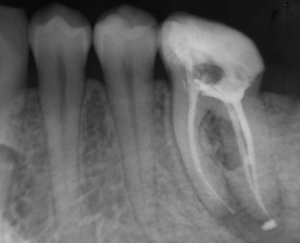
On the photo the perforation of the tooth root with the release of the filling material
If the roots of the tooth are curved, then their perforation with dental instruments is quite common. In this case, the device passes not along the tooth channel, but through the wall of the tooth. The hole formed serves as a "front entrance" for bacteria. As a result, the root of the tooth becomes inflamed, pus is formed and the tooth begins to ache.
If the pin is incorrectly fixed in the canal of the tooth, perforation and the appearance of pain in the subsequent can also occur. To determine its presence, only the X-ray can help.
Fracture of the tool in the tooth channel
In the process of non-observance of the technique of using dental dilators for dental canals, a part of the instrument may break off. 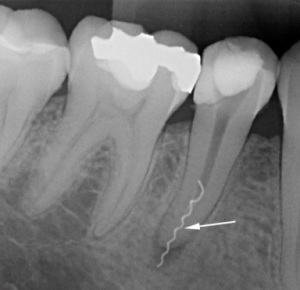 This is possible in case of repeated use of disposable instruments, too much turning in the dental canal( more than 120 degrees) or due to strong curvature of the roots. The doctor may simply not notice a breakdown of the instrument or intentionally carry out a tooth filling with a foreign body inside.
This is possible in case of repeated use of disposable instruments, too much turning in the dental canal( more than 120 degrees) or due to strong curvature of the roots. The doctor may simply not notice a breakdown of the instrument or intentionally carry out a tooth filling with a foreign body inside.
In all these cases, a foci of infection in the roots of the tooth develops. There, purulent masses are formed, the tooth begins to ache, becomes sensitive to pressure. There is discomfort when chewing food, tapping or accidentally touching a sick tooth with a healthy one.
Why did the gum inflame?
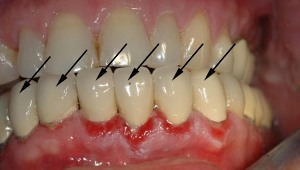
Inflammation of the gum under the crowns of
If the gum is hurt under the crown, then this may be a consequence of its incorrect or insufficient quality installation. In this case, an interval is formed between the prosthesis and soft tissues.
It is very difficult to completely clean it during oral hygiene, there are always stuck pieces of food. As a result, inflammation of the gums occurs, gingivitis develops, and then, possibly, periodontitis. This crown must be replaced.
Another reason may be the excess of the life of the structure. Usually the recommended time for wearing such a permanent prosthesis is not more than 5 years. If this period is exceeded, the crown must be replaced.
What should I do if I have toothache before going to the dentist?
Any pain under the crown is an unkind symptom and requires appropriate treatment. The cause of the painful condition and the ways of its elimination can be determined with accuracy only by a specialist, so for help in such cases, you should definitely contact the dentist.
 But there are cases when an immediate visit to the dental clinic is not possible. What should a patient do in such a situation? And what to remove a aching toothache?
But there are cases when an immediate visit to the dental clinic is not possible. What should a patient do in such a situation? And what to remove a aching toothache?
In such cases for temporary relief, you can resort to some medication or to phytotherapy.
Medication therapy
-
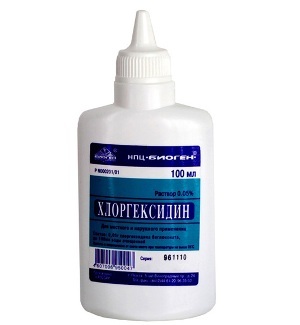 If the pain is very severe, then analgesics will help to remove it: Analgin, Nurofen, Ibuprofen, Najz, Ketanov .But before taking any medications independently, it is necessary to study the instructions and in no case exceed the recommended dose;
If the pain is very severe, then analgesics will help to remove it: Analgin, Nurofen, Ibuprofen, Najz, Ketanov .But before taking any medications independently, it is necessary to study the instructions and in no case exceed the recommended dose; - Hydrogen Peroxide can relieve pain. You can use it as a rinse or compress. To prepare the solution, take 1 tablespoon of the product and mix with a glass of warm water. Rinse the oral cavity every 2 hours, placing emphasis on the affected area. For a compress, a sterile cotton swab or bandage is wetted in a 3% solution of hydrogen peroxide and applied to the gums at the site of the diseased tooth;
- Chlorhexidine or Furacilin may temporarily relieve discomfort and reduce inflammation. Rinse the mouth with these funds should be at least 5 times during the day.
Phytotherapy
In addition to medications, traditional medicine can be used to relieve the condition. They are also very effective, they can remove inflammation and temporarily relieve uncomfortable sensations.
-
 A good effect gives decoctions and infusions from such medicinal plants as chamomile, yarrow, sage, calendula, oak bark and others. To prepare a rinse aid, 1 tablespoon of dry herb is poured with 1 glass of boiling water, cooled to 36 degrees. Oak bark for these purposes must be filled with hot water and boiled for several minutes, only after that it should be cooled. Rinse your mouth at least once every 1.5 to 2 hours;
A good effect gives decoctions and infusions from such medicinal plants as chamomile, yarrow, sage, calendula, oak bark and others. To prepare a rinse aid, 1 tablespoon of dry herb is poured with 1 glass of boiling water, cooled to 36 degrees. Oak bark for these purposes must be filled with hot water and boiled for several minutes, only after that it should be cooled. Rinse your mouth at least once every 1.5 to 2 hours; - root of the aura excellently relieves pain, reduces inflammation, and has disinfectant properties. To achieve the desired effect, a small piece of the plant should be placed in the mouth and held until it softens. The procedure should be repeated several times during the day. You can also use an alcoholic tincture from the root of the aura to prepare the solution and rinse it with a mouth cavity;
-
 Ashberry leaves relieve pain and reduce inflammation; they need to be chewed for this;
Ashberry leaves relieve pain and reduce inflammation; they need to be chewed for this; - Melissa broth has a soothing and analgesic effect. It must be eaten three times a day;
- The crushed garlic clove , attached to the gum, will relieve pain and reduce inflammation. In addition, garlic has an antiseptic effect;
- A mixture of a small amount of ground cinnamon and honey can temporarily relieve the pain.
Only the dentist can eliminate the true cause of the problem.
Treatment for a dentist
How to treat a problem tooth? To solve the problem there are several tactics, but in 90% of cases with the crown will have to part. If the crown was installed on the tooth, affected by caries, the doctor will have to remove the structure, make an x-ray, cure the tooth and only then perform a repeated prosthesis. At the same time, the previous design can not be used, it can not be removed without damage.
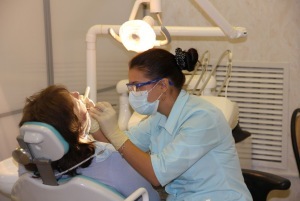 If the crown was installed insufficiently qualitatively or it is not suitable for the patient, it will also have to be removed. After that the doctor removes a repeated impression, the prosthesis is made anew and fixed correctly. The tooth or inflamed gingiva is treated, if necessary.
If the crown was installed insufficiently qualitatively or it is not suitable for the patient, it will also have to be removed. After that the doctor removes a repeated impression, the prosthesis is made anew and fixed correctly. The tooth or inflamed gingiva is treated, if necessary.
If the focus of inflammation is in the tip of the tooth root, then the patient is made X-ray .After this, the crown is removed, the roots are cleaned again. For some time, the dentist can prescribe a mouth rinse. After that, the root canals are again sealed and a new structure is installed.
Toothache under the crown should in no case be ignored. If you let the situation take care of itself, or for a long time to relieve pain at home, then in the end you can completely lose the restored tooth. With timely access to the dentist, the problem can be solved quickly and efficiently.
About the frequent reasons of pain and tactics of treatment the doctor the stomatologist will tell.
